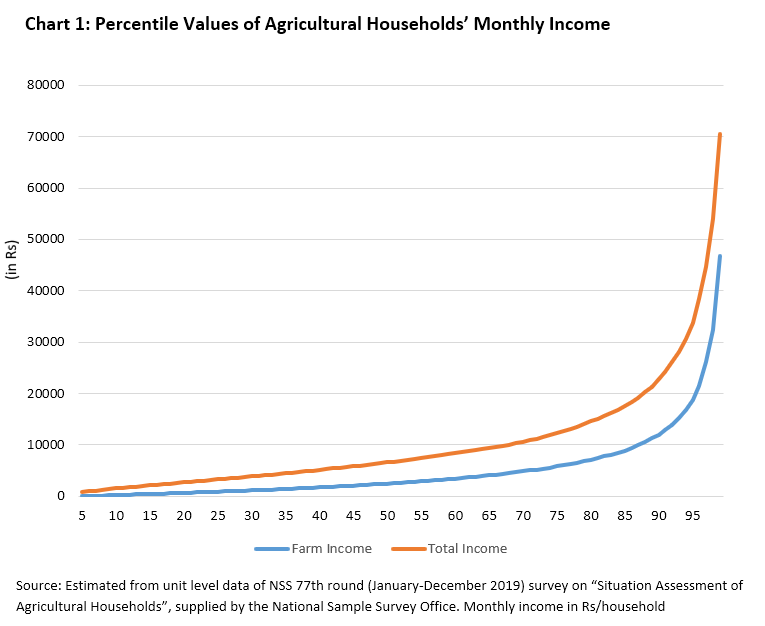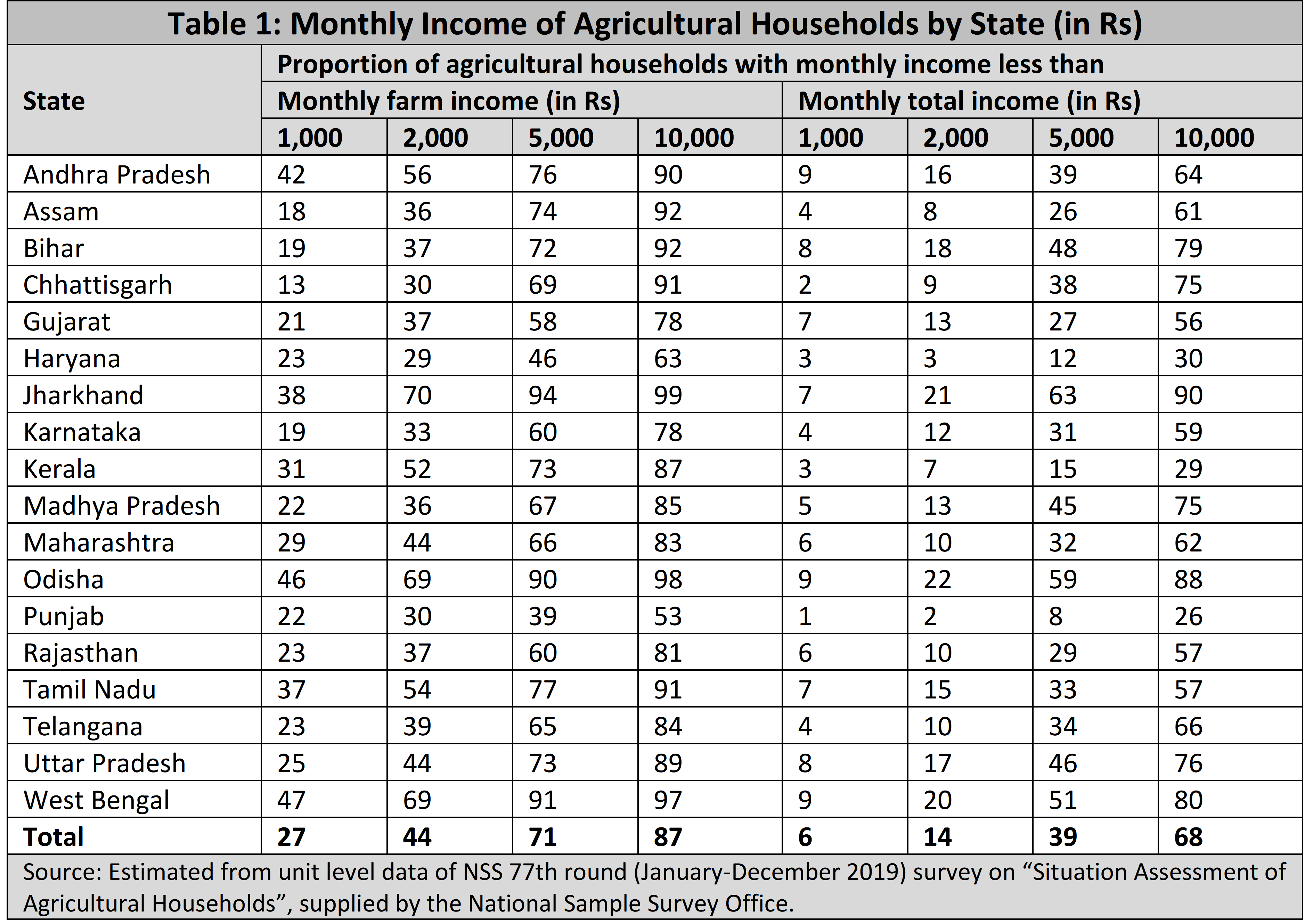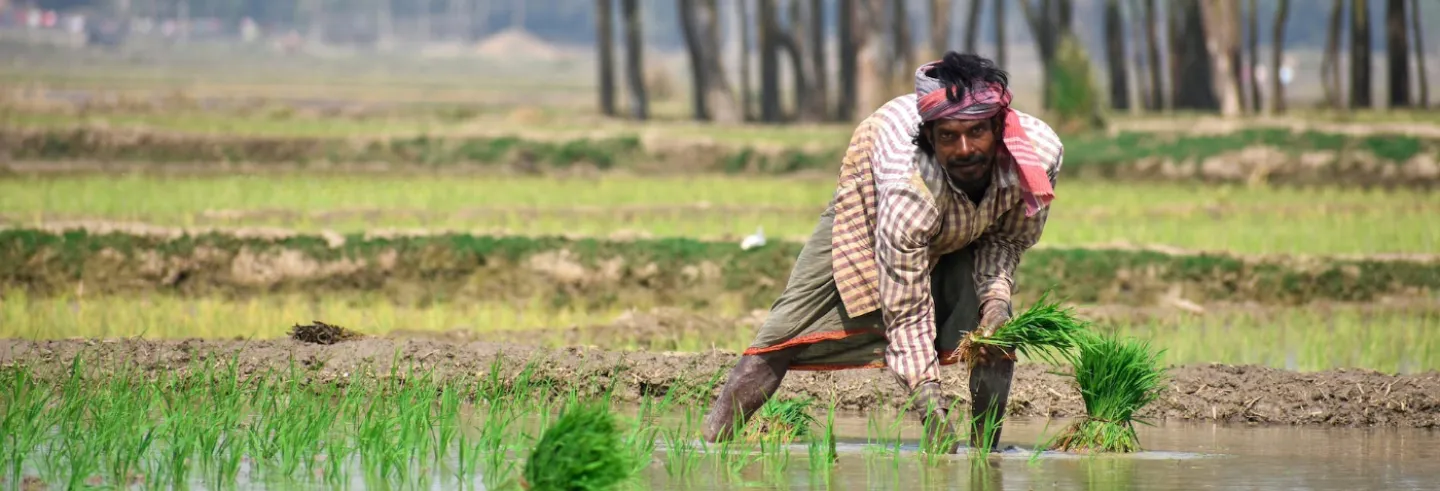The recent release of data from the National Sample Survey’s (NSS) 77th round (January-December 2019) on the “Situation Assessment of Agricultural Households” has sparked a flurry of articles in Indian newspapers, specifically focusing on agricultural household income. These discussions hinge on comparing the average monthly farm income and average monthly total income of agricultural households across states.
According to estimates, the national average stands at Rs. 5,298 for monthly farm income and Rs. 10,695 for average monthly total income. However, it is crucial to note that there is substantial disparity in income distribution among agricultural households, which renders an assessment of farmers’ welfare based solely on these averages very misleading. This article sheds light on the nuanced income distribution landscape among agricultural households.
The NSS 77th round defines an agricultural household as one receiving produce worth more than Rs. 4,000 from agriculture activities and having at least one member who is self employed in agriculture either in the principal or subsidiary status in the last 365 days. According to this criterion, agricultural households account for 54% of rural households in India. For 38.8% of rural households, farming is the principal source of income. Agricultural households that generate at least 50% of their household income from farming make up 31% of all rural households. Only 21% of rural households are entirely dependent on farming.
Chart 1 presents the percentile distribution of monthly farm income for agricultural households in rural India. The 5th percentile value is Rs. 0.00, indicating that 5% of agricultural households earn Rs. 0.00 or less per month, or may have negative returns. The 90th percentile is Rs. 12,017, which shows that 90% of agricultural households receive less than this in monthly farm income.
A rather depressing picture of agricultural households is painted by the percentile distribution of monthly farm income. Only 13% of them earn more than Rs 10,000 a month from farming.
A closer examination of the percentile distribution reveals that the monthly farm income of agricultural households crosses Rs. 1,000 at the 27th percentile, implying that 27% of agriculture households receive a monthly farm income of less than Rs. 1,000. The 44th percentile number is Rs. 1,985, which is closer to Rs. 2,000, meaning that 44% of agricultural households earn a farm income of less than Rs. 2,000 each month. Similarly, 71% of agricultural households earn less than Rs. 5,000 per month, and 87% earn less than Rs. 10,000 per month from farming.
A rather depressing picture of agricultural households is painted by the percentile distribution of monthly farm income. Only 13% of them earn more than Rs 10,000 a month from farming. The average monthly farm income of Rs. 5,298 is very unequally distributed among agricultural households. In all, 72% of agricultural households earn less than this average amount from farming.
Chart 1 also depicts total monthly income. The graph clearly illustrates that non-farm activities increase the monthly income of agricultural households. Of them, 68% earn less than Rs. 10,000 as total monthly income. Or, in other words, 32% of agriculture households earn a monthly income of more than Rs. 10,000. When only farm income is examined, only 13% of agriculture households earn more than Rs. 10,000 per month.
This reflects the importance of non-farm sources of income for agricultural households. Even after accounting for non-farm sources, a sizable number of agricultural households live on a very low total household income. Given the Rs. 5,000 monthly income threshold, 39% of agricultural households earn less than this, and 14% earn less than Rs. 2,000 per month.

Income distribution varies widely between states: We computed the percentile values of monthly farm income and monthly total income for each state to comprehend the inter-state difference (Table 1). Comparisons are a little difficult because each percentile has a distinct value depending on the state, and we have only shown those percentiles that cross the monthly farm income thresholds of Rs. 1,000, Rs. 2,000, Rs. 5,000, and Rs. 10,000. This should tell us what percentage of agricultural households had a monthly farm income less than or above these levels.

It has been observed that non-farm sources increase the monthly income of agricultural households. A large proportion of agricultural households earn a monthly farm income of less than Rs.1,000. It is higher than 40% in states such as Andhra Pradesh, Odisha, and West Bengal. When we look at the total monthly income of agricultural households, we discover that only a small percentage of them have a total monthly income of less than Rs. 1,000. It varies between 1% and 9% among Indian states.
Less than 20% of agricultural households in most states earn a monthly farm income of less than Rs. 10,000. This proportion is less than 10% in eight states. It is as low as 1%, 2%, and 3% in Jharkhand, Odisha, and West Bengal, respectively. When we look at the total monthly income of agricultural households, we notice that a greater proportion of them earn more than Rs. 10,000 than was the case with monthly farm income.
In Jharkhand, Odisha, West Bengal, Bihar, Uttar Pradesh, Chhattisgarh, and Madhya Pradesh, 75% to 90% of agricultural households earn a monthly total income of less than Rs. 10,000.
However, there is a significant disparity between states. The proportion of agricultural households earning a total monthly income of more than Rs. 10,000 ranges from 10% in Jharkhand to 74% in Punjab. The proportion of agricultural households with a total monthly income of Rs. 10,000 in the best-off states is more than seven times that of the worst-off states.
In 15 states, the agricultural households with a total monthly income of more than Rs. 10,000 constitute less than 50% of all farming households, which explains the poor economic condition they are in. It is less than 30% in seven states. Only in three states—Haryana, Kerala, and Punjab—do more than 70% of agricultural households earn a monthly income of more than Rs. 10,000.
Even after accounting for all non-farm income, a considerable proportion of agricultural households in various states earn far too little. In Jharkhand, Odisha, West Bengal, Bihar, Uttar Pradesh, Chhattisgarh, and Madhya Pradesh, 75% to 90% of agricultural households earn a monthly total income of less than Rs. 10,000. These states receive comparatively less as monthly farm income and their income from non-farm sources is also relatively less.
Farm income in India is very unequally distributed among agricultural households. A huge proportion of them earn far too little from farming. Further, the distribution of income varies greatly among the states. Even when non-farm sources are considered, the monthly income of agricultural households is not very encouraging. A very large proportion of them earn a total income of less than Rs. 5,000 per month. This obviously has major implications for the welfare of India’s agricultural households.
Vachaspati Shukla is with the Sardar Patel Institute of Economic and Social Research, Ahmedabad.









